Experimental and Numerical Investigation of a Novel Demountable Timber–Concrete Composite Floor
Abstract
:1. Introduction
2. Experimental Study
2.1. The Demountable TCC Floor System
2.2. Fabrication
2.3. Downscaled Model
2.3.1. Concrete
2.3.2. Timber
2.4. Experimental Setup
2.5. Experimental Results
2.6. Analytical Analysis
3. Numerical Study
3.1. Material Modeling
3.1.1. Concrete
3.1.2. Timber
3.2. Results and Discussion
4. Parametric Study
5. Conclusions
- The floor system is fully demountable before and after failure;
- The proposed construction method of the floor system facilitates the prefabrication and installation of the slab;
- The slab has a noticeable efficiency of 0.73 of the composite action;
- The studied parameters mostly affect the load-bearing capacity and the deflection at the failure of the slab rather than its stiffness;
- The birdsmouth notch increases the ductility of the slab compared to rectangular and triangular notches;
- The position of the bolt can vary the load-bearing capacity up to 20%;
- The length of the notch does not have a significant influence on the strength of the slab;
- An increase in the timber length in front of the notch increases the bearing capacity of the shear connection;
- An excessive increase in the notch’s depth decreases the bending capacity of the slab;
Author Contributions
Funding
Data Availability Statement
Conflicts of Interest
References
- Gálvez-Martos, J.-L.; Styles, D.; Schoenberger, H.; Zeschmar-Lahl, B. Construction and Demolition Waste Best Management Practice in Europe. Resour. Conserv. Recycl. 2018, 136, 166–178. [Google Scholar] [CrossRef] [Green Version]
- Kanters, J. Design for Deconstruction in the Design Process: State of the Art. Buildings 2018, 8, 150. [Google Scholar] [CrossRef] [Green Version]
- Allam, A.S.; Nik-Bakht, M. From Demolition to Deconstruction of the Built Environment: A Synthesis of the Literature. J. Build. Eng. 2023, 64, 105679. [Google Scholar] [CrossRef]
- Zhou, H.; Lu, W.; Lu, B.; Wang, L.; Bao, Y.; Zhang, J.; Chen, Z. Experimental and Numerical Analyses on the Fire Resistance of Timber–Concrete Composite Boards Using an Innovative Form of Partial Protection. Buildings 2023, 13, 725. [Google Scholar] [CrossRef]
- Ceccotti, A. Timber-Concrete Composite Structures. Timber Eng. 1995, 2, E13. [Google Scholar] [CrossRef]
- Dias, A.; Schänzlin, J.; Dietsch, P. Design of Timber-Concrete Composite Structures. In A State-of-the-Art Report by COST Action FP1402/WG; Shaker: Aachen, Germany, 2018; Volume 4. [Google Scholar]
- Monteiro, S.; Dias, A.; Lopes, S. Distribution of Concentrated Loads in Timber-Concrete Composite Floors: Simplified Approach. Buildings 2020, 10, 32. [Google Scholar] [CrossRef] [Green Version]
- Siddika, A.; Mamun, M.A.A.; Aslani, F.; Zhuge, Y.; Alyousef, R.; Hajimohammadi, A. Cross-Laminated Timber–Concrete Composite Structural Floor System: A State-of-the-Art Review. Eng. Fail. Anal. 2021, 130, 105766. [Google Scholar] [CrossRef]
- De Santis, Y.; Sciomenta, M.; Spera, L.; Rinaldi, V.; Fragiacomo, M.; Bedon, C. Effect of Interlayer and Inclined Screw Arrangements on the Load-Bearing Capacity of Timber-Concrete Composite Connections. Buildings 2022, 12, 2076. [Google Scholar] [CrossRef]
- Steinberg, E.; Selle, R.; Faust, T. Connectors for Timber–Lightweight Concrete Composite Structures. J. Struct. Eng. 2003, 129, 1538–1545. [Google Scholar] [CrossRef]
- Bao, Y.; Lu, W.; Yue, K.; Zhou, H.; Lu, B.; Chen, Z. Structural Performance of Cross-Laminated Timber-Concrete Composite Floors with Inclined Self-Tapping Screws Bearing Unidirectional Tension-Shear Loads. J. Build. Eng. 2022, 55, 104653. [Google Scholar] [CrossRef]
- Negrão, J.H.J. de O.; Maia de Oliveira, F.M.; Leitão de Oliveira, C.A.; Cachim, P.B. Glued Composite Timber-Concrete Beams.II: Analysis and Tests of Beam Specimens. J. Struct. Eng. 2010, 136, 1246–1254. [Google Scholar] [CrossRef]
- Clouston, P.; Civjan, S.; Bathon, L. Experimental Behavior of a Continuous Metal Connector for a Wood-Concrete Composite System. For. Prod. J. 2004, 54, 10. [Google Scholar]
- Xu, Q.; Wang, M.; Chen, L.; Harries, K.A.; Song, X.; Wang, Z. Mechanical Performance of Notched Shear Connections in CLT-Concrete Composite Floor. J. Build. Eng. 2023, 70, 106364. [Google Scholar] [CrossRef]
- Zhang, L.; Chui, Y.H.; Tomlinson, D. Experimental Investigation on the Shear Properties of Notched Connections in Mass Timber Panel-Concrete Composite Floors. Constr. Build. Mater. 2020, 234, 117375. [Google Scholar] [CrossRef]
- Boccadoro, L.; Zweidler, S.; Steiger, R.; Frangi, A. Bending Tests on Timber-Concrete Composite Members Made of Beech Laminated Veneer Lumber with Notched Connection. Eng. Struct. 2017, 132, 14–28. [Google Scholar] [CrossRef]
- Van Thai, M.; Ménard, S.; Elachachi, S.M.; Galimard, P. Performance of Notched Connectors for CLT-Concrete Composite Floors. Buildings 2020, 10, 122. [Google Scholar] [CrossRef]
- Yeoh, D.; Fragiacomo, M.; De Franceschi, M.; Buchanan, A.H. Experimental Tests of Notched and Plate Connectors for LVL-Concrete Composite Beams. J. Struct. Eng. 2011, 137, 261–269. [Google Scholar] [CrossRef]
- Mirdad, M.A.H.; Khan, R.; Chui, Y.H. Analytical Procedure for Timber−Concrete Composite (TCC) System with Mechanical Connectors. Buildings 2022, 12, 885. [Google Scholar] [CrossRef]
- Kuklík, P.; Nechanický, P.; Kuklíková, A. Development of Prefabricated Timber-Concrete Composite Floors. In Materials and Joints in Timber Structures; Aicher, S., Reinhardt, H.-W., Garrecht, H., Eds.; Springer: Dordrecht, The Netherlands, 2014; pp. 463–470. ISBN 978-94-007-7810-8. [Google Scholar]
- Yilmaz, S.; Demir, S.; Vural, N. Experimental Investigation of a Prefabricated Timber-Concrete Composite Floor Structure: Notched-Slab Approach. Adv. Concr. Constr. 2021, 12, 13–23. [Google Scholar] [CrossRef]
- Yeoh, D.; Fragiacomo, M. The Design of a Semi-Prefabricated LVL-Concrete Composite Floor. Adv. Civ. Eng. 2012, 2012, 626592. [Google Scholar] [CrossRef] [Green Version]
- Sebastian, W.; Webb, S.; Nagree, H.S. Orthogonal Distribution and Dynamic Amplification Characteristics of Partially Prefabricated Timber-Concrete Composites. Eng. Struct. 2020, 219, 110693. [Google Scholar] [CrossRef]
- Crocetti, R.; Sartori, T.; Tomasi, R. Innovative Timber-Concrete Composite Structures with Prefabricated FRC Slabs. J. Struct. Eng. 2015, 141, 04014224. [Google Scholar] [CrossRef]
- Crocetti, R.; Sartori, T.; Flansbjer, M. Timber-Concrete Composite Structures with Prefabricated FRC Slab. In Proceedings of the 11th World Conference on Timber Engineering, Trentino, Italy, 20–24 June 2010; Volume 1, pp. 121–130. [Google Scholar]
- Sartori, T.; Crocetti, R. Prefabricated Timber-Concrete Composite Floors. Eur. J. Wood Wood Prod. 2016, 74, 483–485. [Google Scholar] [CrossRef]
- Lukaszewska, E.; Johnsson, H.; Fragiacomo, M. Performance of Connections for Prefabricated Timber–Concrete Composite Floors. Mater. Struct. 2008, 41, 1533–1550. [Google Scholar] [CrossRef]
- Lukaszewska, E.; Fragiacomo, M.; Johnsson, H. Laboratory Tests and Numerical Analyses of Prefabricated Timber-Concrete Composite Floors. J. Struct. Eng. 2010, 136, 46–55. [Google Scholar] [CrossRef]
- Shi, B.; Zhu, W.; Yang, H.; Liu, W.; Tao, H.; Ling, Z. Experimental and Theoretical Investigation of Prefabricated Timber-Concrete Composite Beams with and without Prestress. Eng. Struct. 2020, 204, 109901. [Google Scholar] [CrossRef]
- Shi, B.; Liu, W.; Yang, H. Experimental Investigation on the Long-Term Behaviour of Prefabricated Timber-Concrete Composite Beams with Steel Plate Connections. Constr. Build. Mater. 2021, 266, 120892. [Google Scholar] [CrossRef]
- Ataei, A.; Bradford, M.A.; Valipour, H. Sustainable Design of Deconstructable Steel-Concrete Composite Structures. Procedia Eng. 2016, 145, 1153–1160. [Google Scholar] [CrossRef] [Green Version]
- Hosseini, S.M.; Mashiri, F.; Mirza, O. Research and Developments on Strength and Durability Prediction of Composite Beams Utilising Bolted Shear Connectors (Review). Eng. Fail. Anal. 2020, 117, 104790. [Google Scholar] [CrossRef]
- He, J.; Feng, S.; Vasdravellis, G.; Xin, H.; Correia, J.A.F.O.; Berto, F. Behaviour of the Lockbolt Demountable Shear Connector under Combined Shear and Tension Loading. Eng. Fail. Anal. 2022, 141, 106712. [Google Scholar] [CrossRef]
- Shamel Fahmy, A.; Mostafa Swelem, S.; Kamal Abdelaziz, M. Behavior of High-Strength Demountable Bolted Shear Connectors in Steel-Concrete Girders with Prefabricated Slabs. Alex. Eng. J. 2023, 70, 247–260. [Google Scholar] [CrossRef]
- Khorsandnia, N.; Valipour, H.; Schänzlin, J.; Crews, K. Experimental Investigations of Deconstructable Timber–Concrete Composite Beams. J. Struct. Eng. 2016, 142, 04016130. [Google Scholar] [CrossRef]
- Khorsandnia, N.; Valipour, H.; Bradford, M. Deconstructable Timber-Concrete Composite Beams with Panelised Slabs: Finite Element Analysis. Constr. Build. Mater. 2018, 163, 798–811. [Google Scholar] [CrossRef]
- Derikvand, M.; Fink, G. Deconstructable Connector for TCC Floors Using Self-Tapping Screws. J. Build. Eng. 2021, 42, 102495. [Google Scholar] [CrossRef]
- Derikvand, M.; Fink, G. Bending Properties of Deconstructable Cross-Laminated Timber-Concrete Composite Floor Elements. Wood Mater. Sci. Eng. 2022, 17, 253–260. [Google Scholar] [CrossRef]
- Dias, A.M.P.G.; Martins, A.R.D.; Simões, L.M.C.; Providência, P.M.; Andrade, A.A.M. Statistical Analysis of Timber–Concrete Connections—Mechanical Properties. Comput. Struct. 2015, 155, 67–84. [Google Scholar] [CrossRef]
- Premiumzemente. Available online: https://www.dyckerhoff.com/premiumzemente (accessed on 4 June 2023).
- DIN EN 196-1:1995-05; Prüfverfahren für Zement Teil 1: Bestimmung der Festigkeit. Comité Européen de Normalisation: Ville de Bruxelles, Belgium, 2005.
- MasterGlenium ACE 456. Available online: https://mbcc.sika.com/en-ae/products/masterglenium/masterglenium-ace-456 (accessed on 4 June 2023).
- Flaga, K.; Derkowski, W.; Surma, M. Concrete Strength and Elasticity of Precast Thin-Walled Elements. Cem. Wapno Beton 2016, 2016, 310–317. [Google Scholar]
- ILNAS-EN 338: 2016; Structural Timber—Strength Classes. Comité Européen de Normalisation: Ville de Bruxelles, Belgium, 2016.
- Šubic, B.; Fajdiga, G.; Lopatič, J. Bending Stiffness, Load-Bearing Capacity and Flexural Rigidity of Slender Hybrid Wood-Based Beams. Forests 2018, 9, 703. [Google Scholar] [CrossRef] [Green Version]
- Ceccotti, A. Composite Concrete-Timber Structures. Prog. Struct. Eng. Mater. 2002, 4, 264–275. [Google Scholar] [CrossRef]
- ILNAS-EN 1995-1-1:2004; Eurocode 5: Design of Timber Structures—Part 1-1: General—Common Rules and Rules for Buildings. Comité Européen de Normalisation: Ville de Bruxelles, Belgium, 2004.
- Gutkowski, R.M.; Goodman, J.R.; Pault, J.D.; Bodig, J. Tests and Analysis for Composite Action in Glulam Bridge Systems; The Engineering Foundation for Grant Rc-A-74-6; Colorado State University: Fort Collins, CO, USA, 1977; p. 49. [Google Scholar]
- Dias, A.M.P.G.; Helena, C.; Lopes, S.; Kuilen, J.W.G. Experimental Shear–Friction Tests on Dowel-Type Fastener Timber–Concrete Joints. In Proceedings of the 8th World Conference on Timber Engineering, Lahti, Finland, 14–17 June 2004. [Google Scholar]
- Rabbat, B.G.; Russell, H.G. Friction Coefficient of Steel on Concrete or Grout. J. Struct. Eng. 1985, 111, 505–515. [Google Scholar] [CrossRef]
- Koubek, R.; Dedicova, K. Friction of Wood on Steel; Linnaeus University, Faculty of Technology: Växjö, Sweden, 2014. [Google Scholar]
- SIMULIA. Abaqus 6.11 Theory Manual; Dassault Systèmes: Vélizy-Villacoublay, France, 2011; Chapter 4. [Google Scholar]
- Wee, T.H.; Chin, M.S.; Mansur, M.A. Stress-Strain Relationship of High-Strength Concrete in Compression. J. Mater. Civ. Eng. 1996, 8, 70–76. [Google Scholar] [CrossRef]
- Olsen, N.H.; Krenchel, H.; Shah, S.P. Mechanical Properties of High Strength Concrete. IABSE Rep. 1987, 55, 395–400. [Google Scholar] [CrossRef]
- Carreira, D.J.; Chu, K.-H. Stress-Strain Relationship for Plain Concrete in Compression. ACI J. Proc. 1985, 82, 797–804. [Google Scholar] [CrossRef]
- Federation Internationale du Beton; Beverly, P. Fib Model Code for Concrete Structures 2010; Ernst & Sohn: Berlin, Germany, 2013; ISBN 978-3-433-60421-2. [Google Scholar]
- Eslami, H.; Jayasinghe, L.B.; Waldmann, D. Nonlinear Three-Dimensional Anisotropic Material Model for Failure Analysis of Timber. Eng. Fail. Anal. 2021, 130, 105764. [Google Scholar] [CrossRef]
- Hoffman, O. The Brittle Strength of Orthotropic Materials. J. Compos. Mater. 1967, 1, 200–206. [Google Scholar] [CrossRef]
- Hill, R. A Theory of the Yielding and Plastic Flow of Anisotropic Metals. Proc. R. Soc. Lond. Ser. A Math. Phys. Sci. 1948, 193, 281–297. [Google Scholar] [CrossRef]

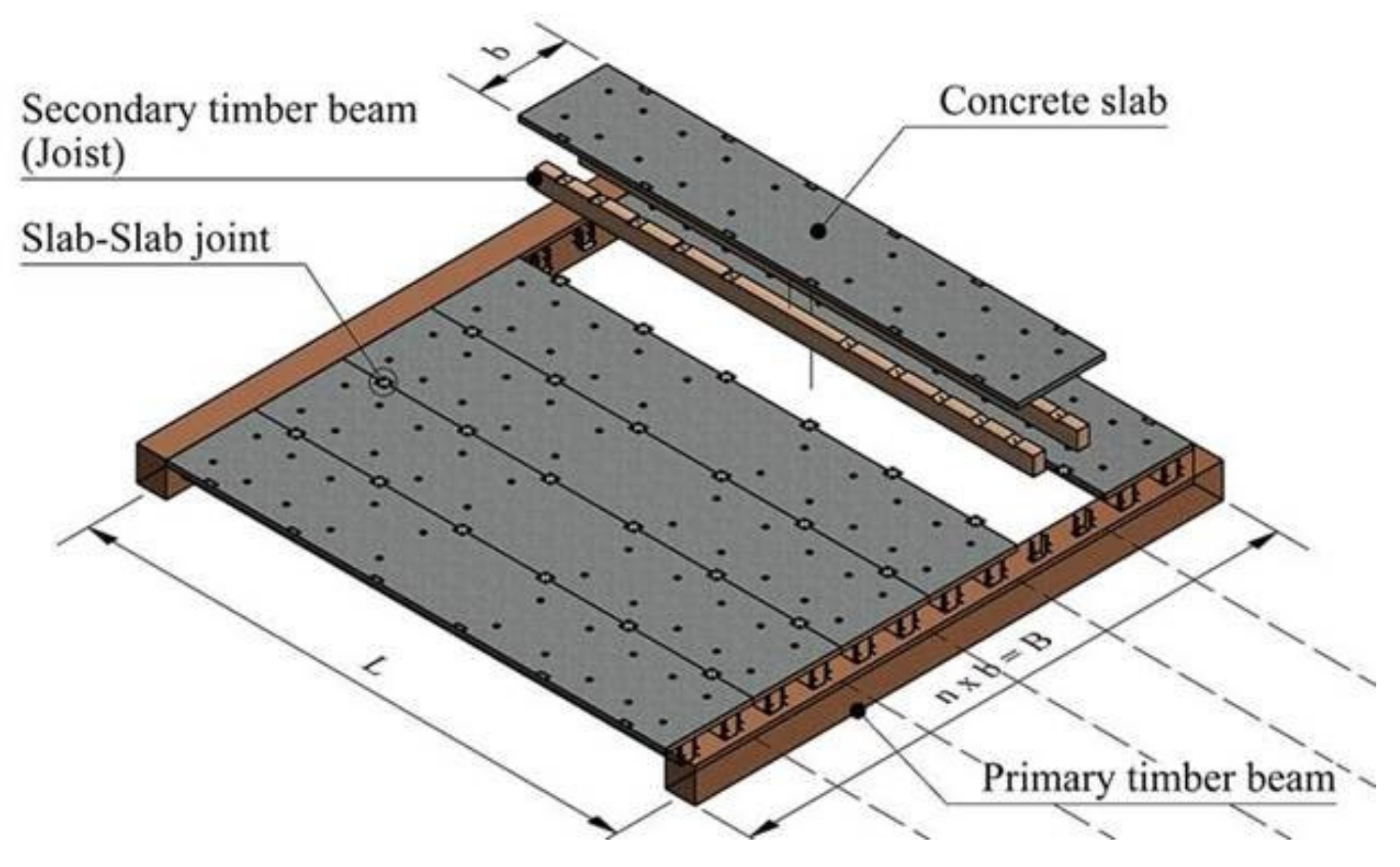
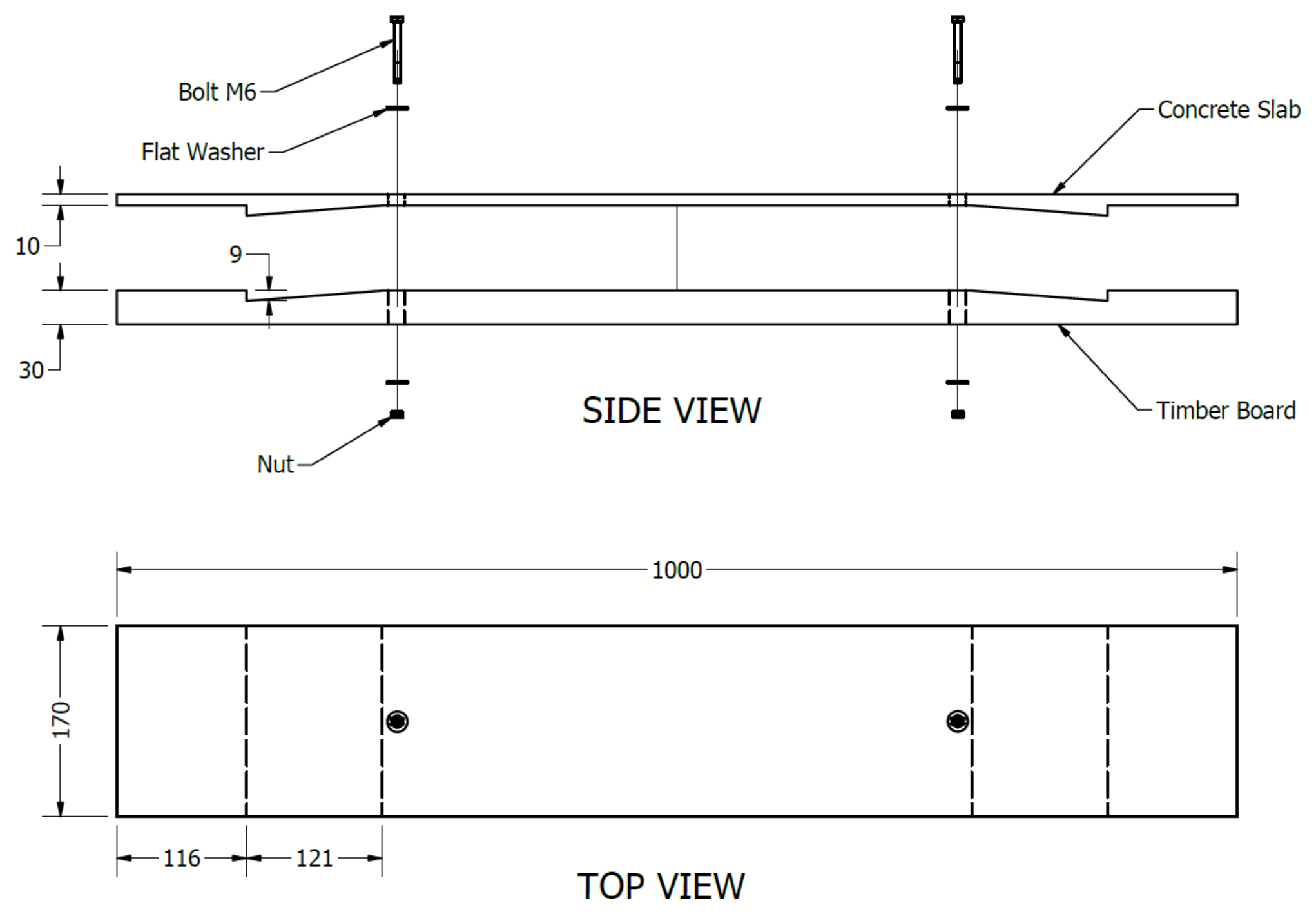
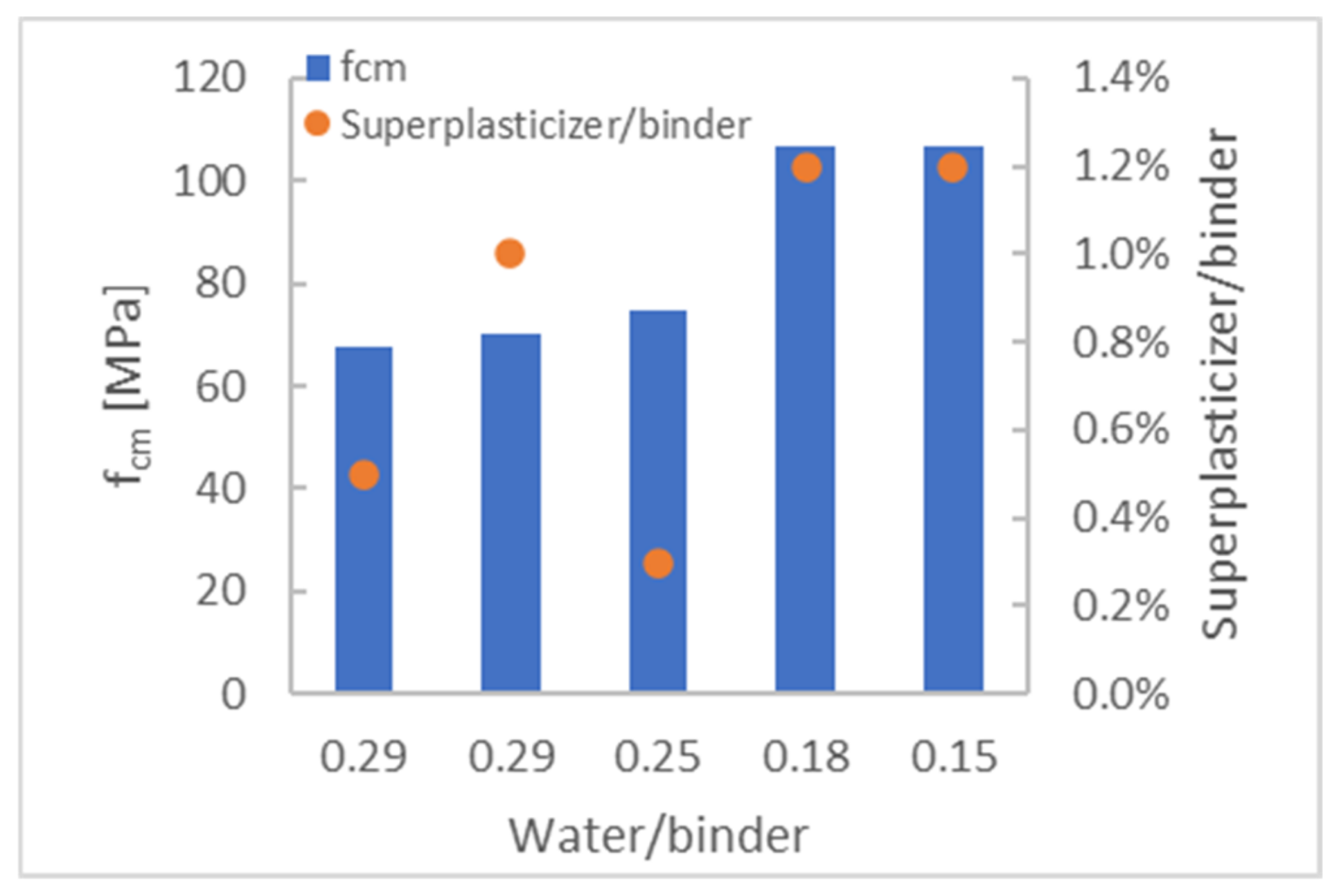
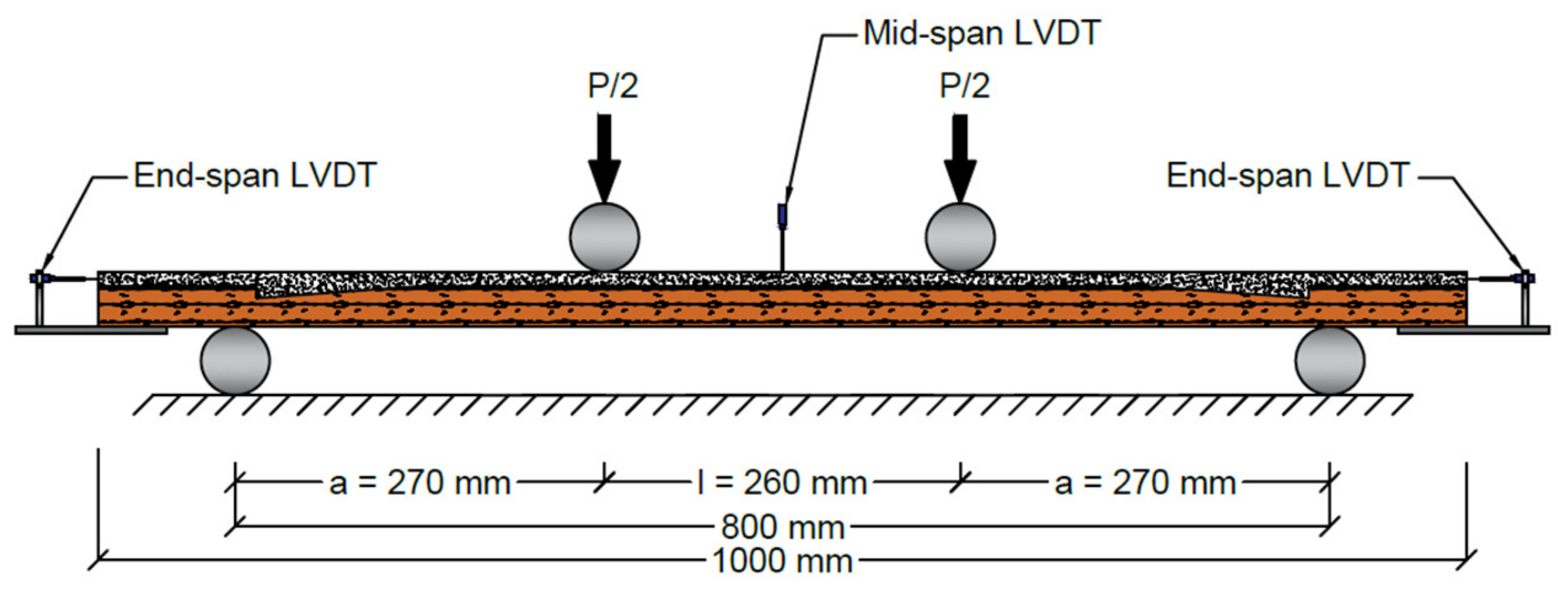

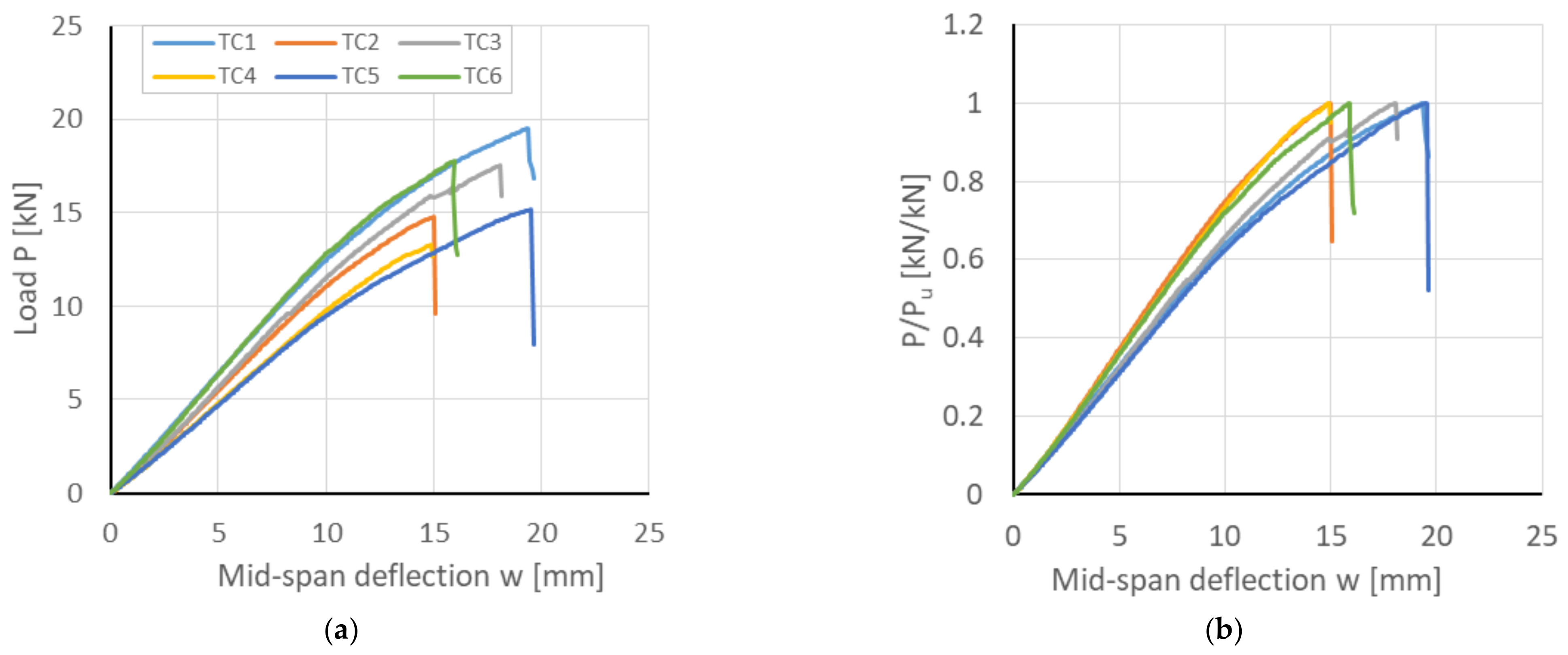


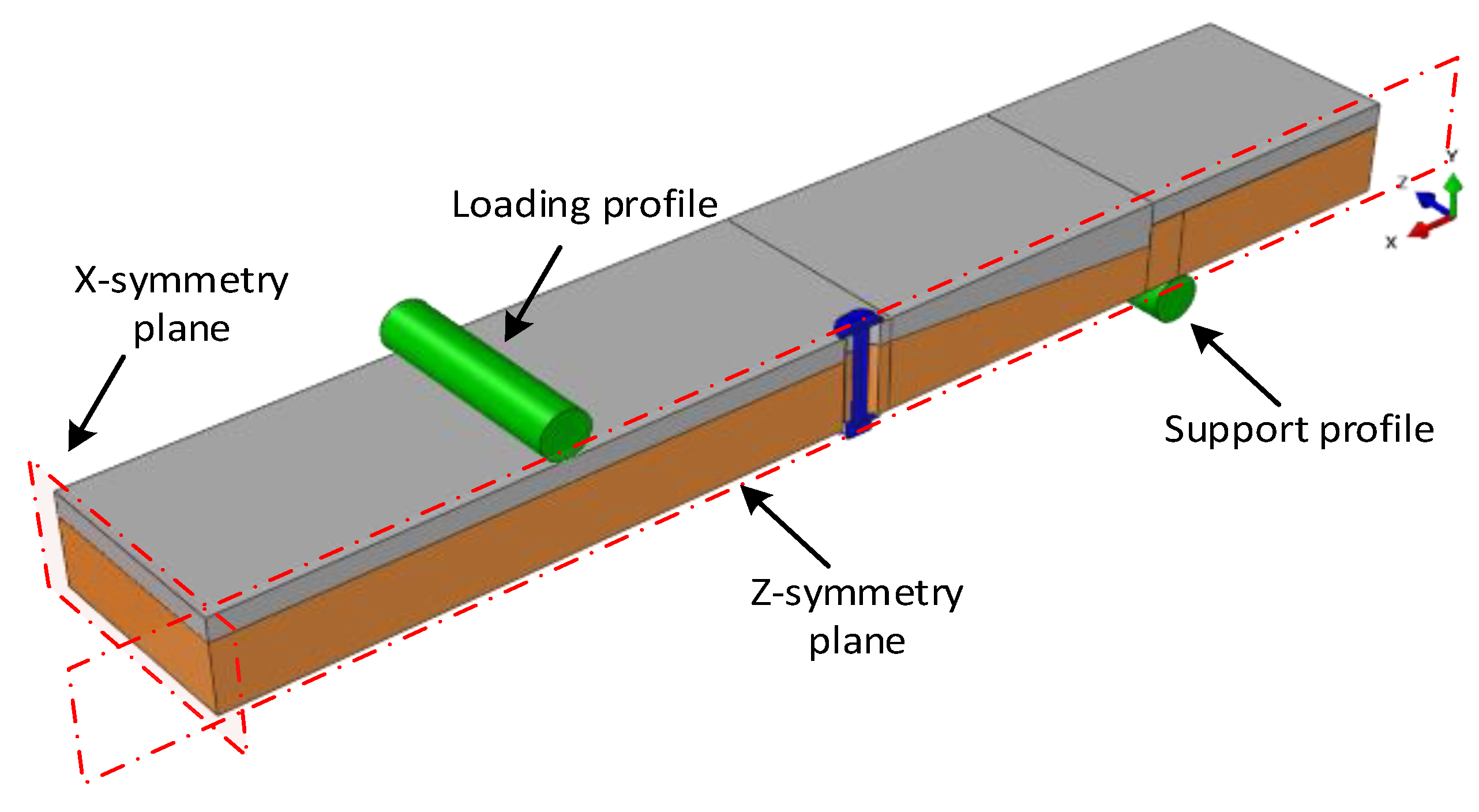
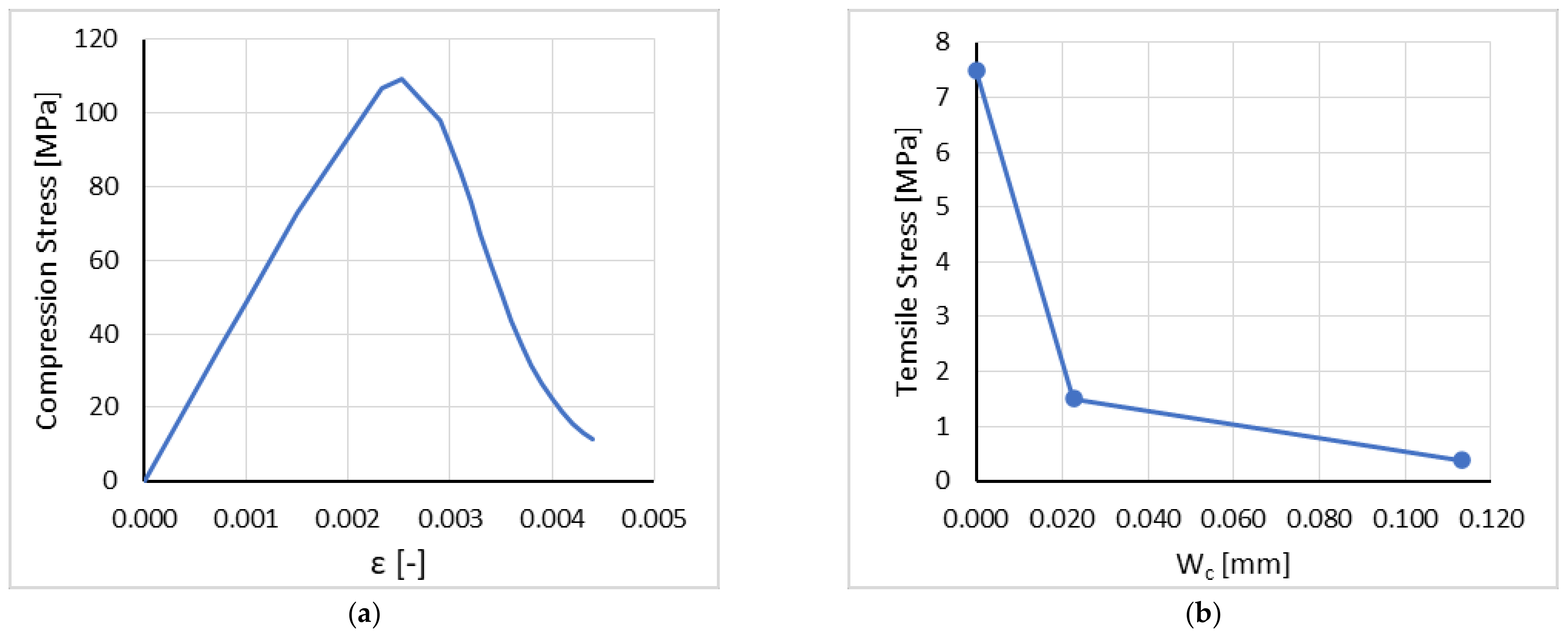
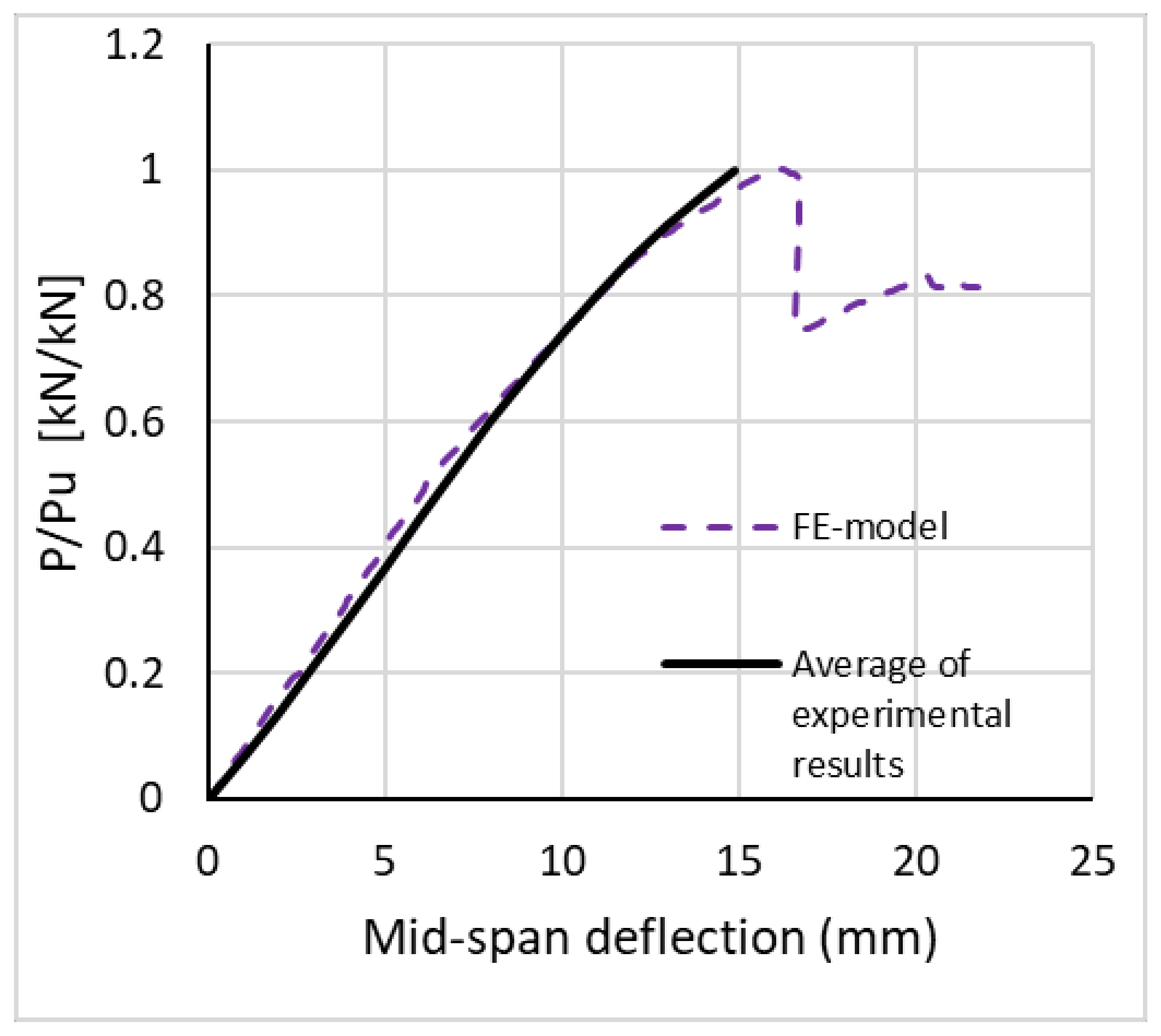

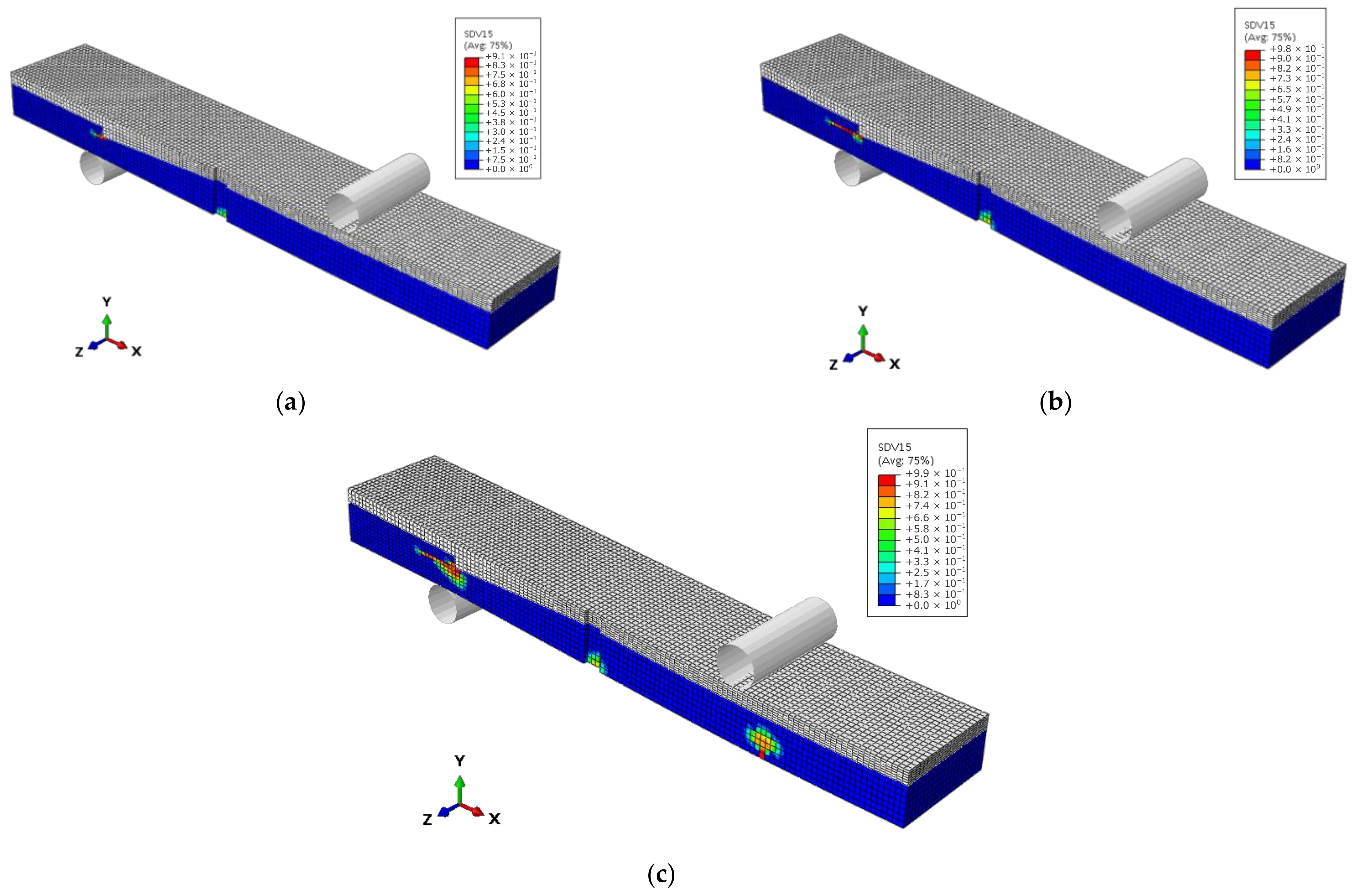

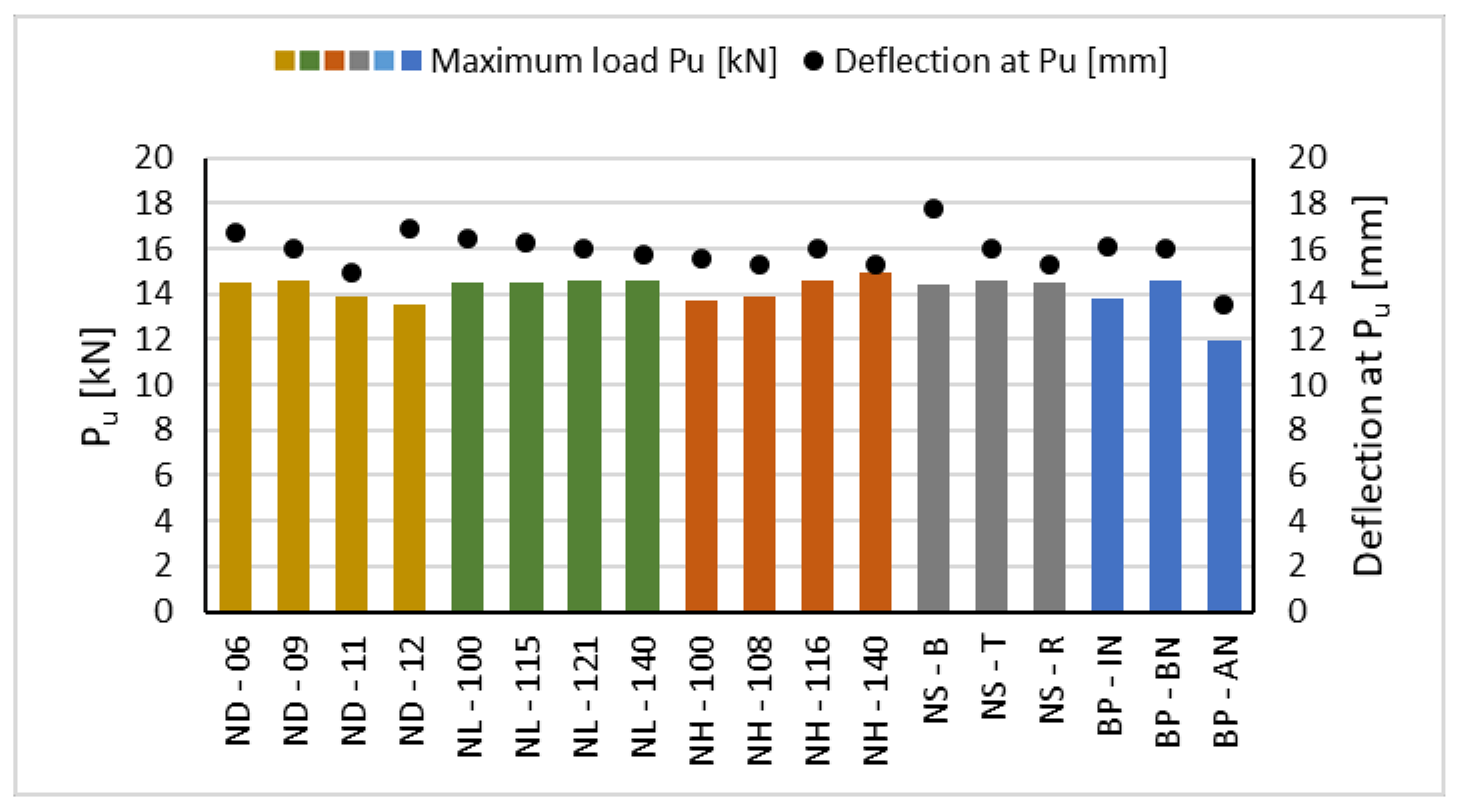
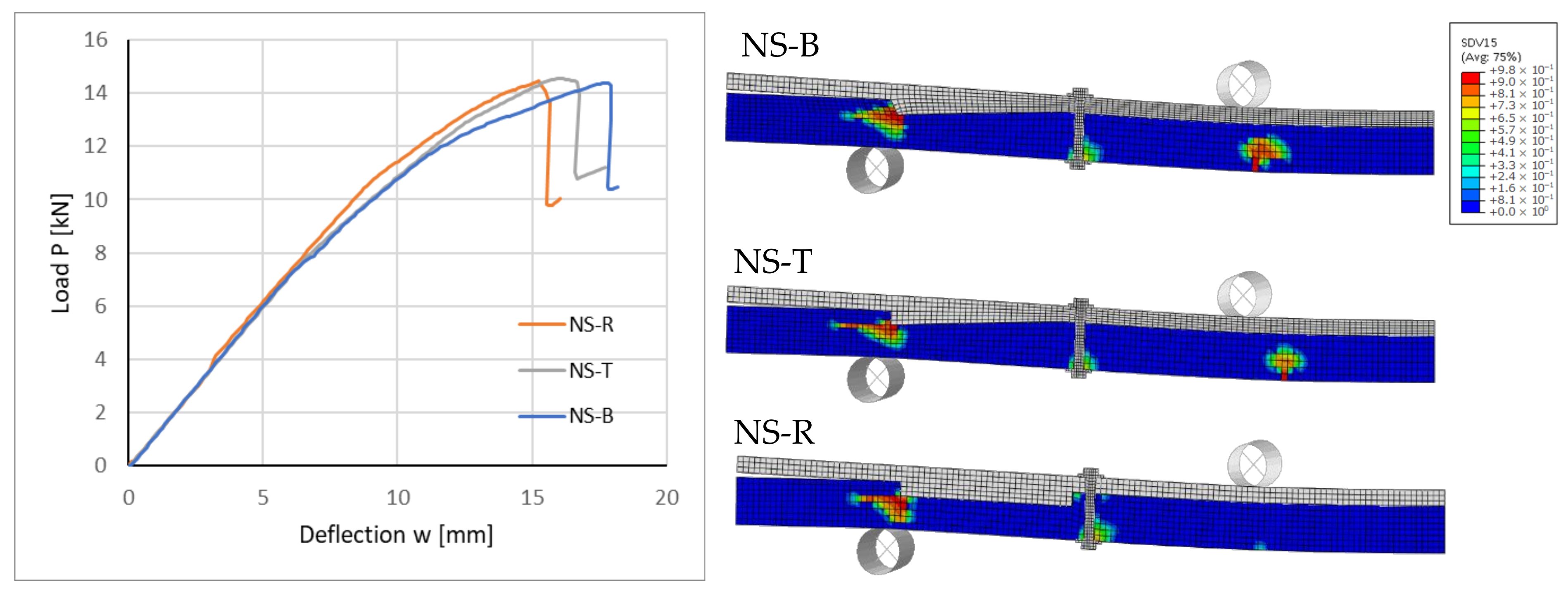
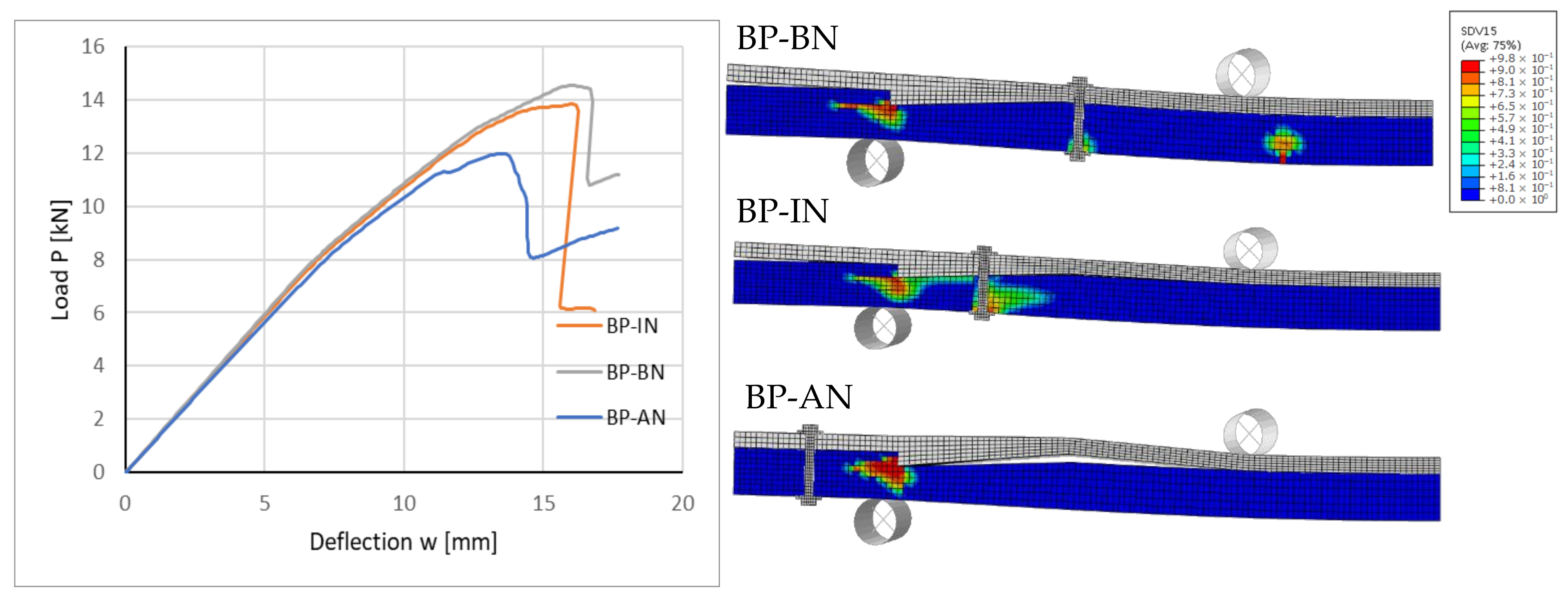

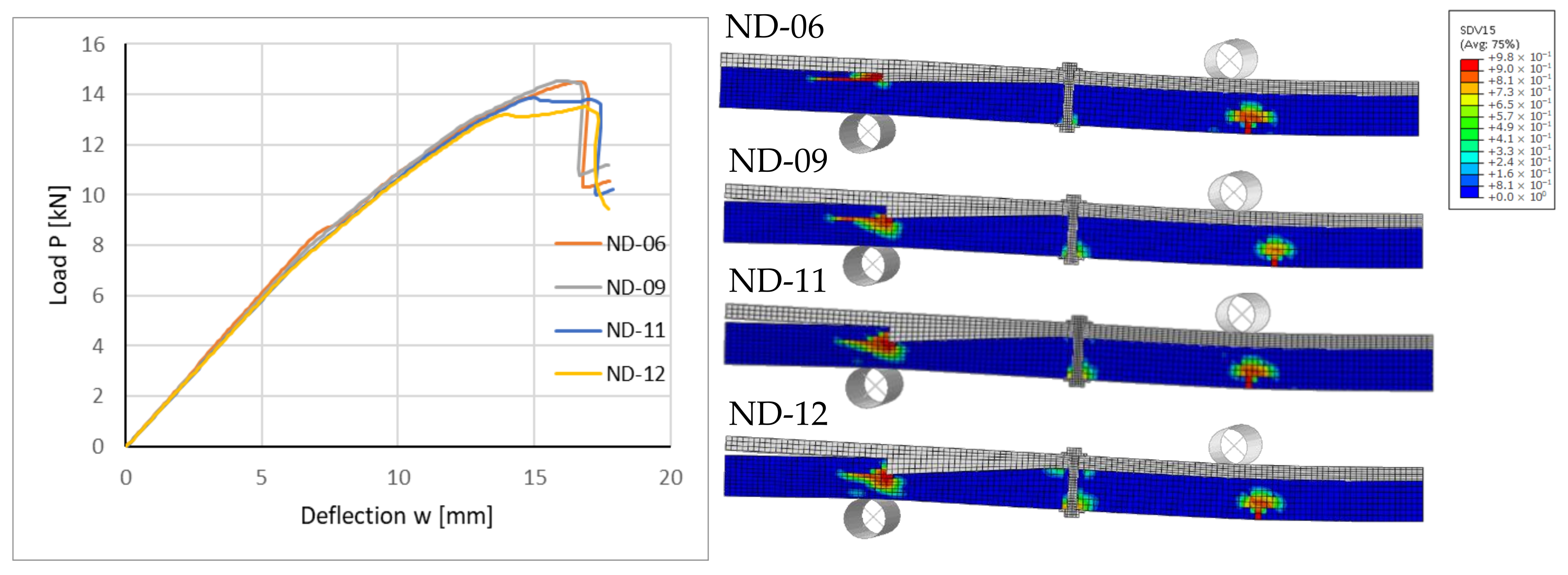
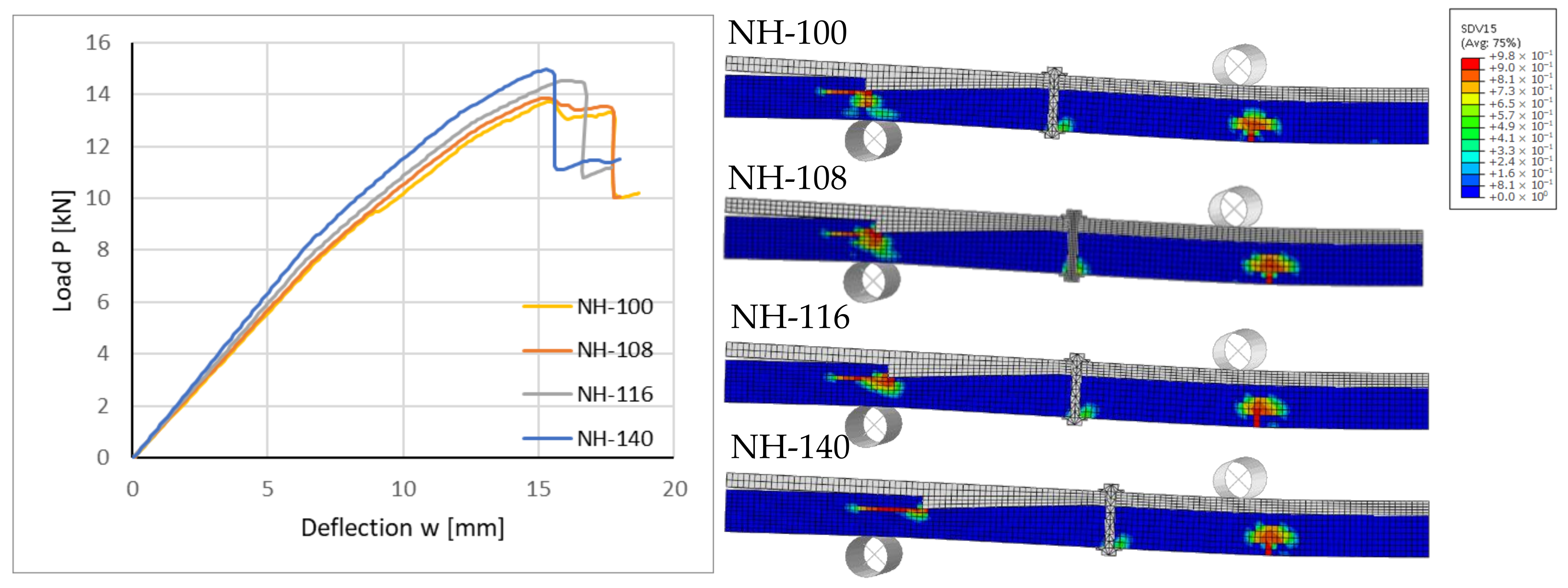
| Item | Amount [kg/m3] |
|---|---|
| Sand | 1108 |
| Binder | 1108 |
| Water | 169 |
| Superplasticizer | 13.4 |
| Total | 2399 |
| Compression Strength [MPa] | Modulus of Elasticity [GPa] | Tensile Splitting Strength [MPa] | |
|---|---|---|---|
| Range | 105.5–113.1 | 43.9–46.0 | 6.9–7.8 |
| Average | 109.1 | 45.0 | 7.5 |
| SD | 2.8 | 1.1 | 0.5 |
| COV [%] | 2.6 | 2.3 | 6.7 |
| Strength Properties [MPa] | |
| Bending | 24 |
| Tension parallel | 14 |
| Tension perpendicular | 0.4 |
| Compression parallel | 21 |
| Compression perpendicular | 2.5 |
| Shear | 4 |
| Stiffness Properties [MPa] | |
| Mean Modulus of Elasticity parallel to grain direction | 11,000 |
| Mean Modulus of Elasticity perpendicular to grain direction | 370 |
| Mean Shear Modulus | 690 |
| Mean density [kg/m3] | 420 |
| At Ultimate Load | At 30% of the Ultimate Load | Effective Rigidity | |||||
|---|---|---|---|---|---|---|---|
| Specimens No. | Pu [kN] | wu [mm] | ku [kN/mm] | P0.3 [kN] | w0.3 [mm] | k0.3 [kN/mm] | (EI)eff [kN.m2] |
| T1 | 19.5 | 19.4 | 1.01 | 5.9 | 4.6 | 1.29 | 11.8 |
| T2 | 14.8 | 15.0 | 0.99 | 4.4 | 4.1 | 1.09 | 10.0 |
| T3 | 17.5 | 18.0 | 0.97 | 5.3 | 4.6 | 1.13 | 10.4 |
| T4 | 13.3 | 14.9 | 0.89 | 4.0 | 4.2 | 0.95 | 8.7 |
| T5 | 15.2 | 19.5 | 0.78 | 4.6 | 4.8 | 0.94 | 8.6 |
| T6 | 17.8 | 15.9 | 1.12 | 5.3 | 4.2 | 1.26 | 11.5 |
| Average | 16.3 | 17.1 | 0.96 | 4.9 | 4.4 | 1.11 | 10.2 |
| SD | 2.10 | 1.95 | 0.10 | 0.63 | 0.27 | 0.13 | 1.22 |
| CV% | 12.9% | 11.4% | 10.8% | 12.9% | 6.2% | 12.0% | 12.0% |
| Composite Connection | γc | γt | (EI)eff [kN·m2] |
|---|---|---|---|
| No composite | 0 | 1 | 4.8 |
| Experimented connection | 0.23 | 1 | 10.2 |
| Full composite | 1 | 1 | 17.8 |
| Elasticity Parameters | |||||
| E1 [MPa] | E2 = E3 [MPa] | G23 [MPa] | G12 = G13 [MPa] | ν23 | ν12 = ν13 |
| 11,000 | 370 | 60 | 690 | 0.5 | 0.45 |
| Strength parameters | |||||
| σ1c [MPa] | σ2c = σ3c [MPa] | σ1t [MPa] | σ2t = σ3t [MPa] | σ23 [MPa] | σ12 = σ13 [MPa] |
| 54 | 6.9 | 36 | 0.7 | 0.5 | 3.5 |
| Hardening parameters | |||||
| h [MPa] | |||||
| 6436 | |||||
| Fracture energies | |||||
| G1t, f [N/mm] | G2t,f [N/mm] | G3t, f [N/mm] | |||
| 10 | 0.2 | 0.2 | |||
| Model | Notch Depth [mm] | Notch Length [mm] | Notch Head [mm] | Notch Shape | Bolt Position |
|---|---|---|---|---|---|
| ND—06 | 6 | 121 | 116 | Triangular | BN |
| ND—09 | 9 | 121 | 116 | Triangular | BN |
| ND—11 | 11 | 121 | 116 | Triangular | BN |
| ND—12 | 12 | 121 | 116 | Triangular | BN |
| NL—100 | 9 | 100 | 116 | Triangular | BN |
| NL—115 | 9 | 115 | 116 | Triangular | BN |
| NL—121 | 9 | 121 | 116 | Triangular | BN |
| NL—140 | 9 | 140 | 116 | Triangular | BN |
| NH—100 | 9 | 121 | 100 | Triangular | BN |
| NH—108 | 9 | 121 | 108 | Triangular | BN |
| NH—116 | 9 | 121 | 116 | Triangular | BN |
| NH—140 | 9 | 121 | 140 | Triangular | BN |
| NS—B | 9 | 121 | 116 | Birdsmouth | BN |
| NS—T | 9 | 121 | 116 | Triangular | BN |
| NS—R | 9 | 121 | 116 | Rectangular | BN |
| BP—IN | 9 | 121 | 116 | Triangular | IN |
| BP—BN | 9 | 121 | 116 | Triangular | BN |
| BP—AN | 9 | 121 | 116 | Triangular | AN |
Disclaimer/Publisher’s Note: The statements, opinions and data contained in all publications are solely those of the individual author(s) and contributor(s) and not of MDPI and/or the editor(s). MDPI and/or the editor(s) disclaim responsibility for any injury to people or property resulting from any ideas, methods, instructions or products referred to in the content. |
© 2023 by the authors. Licensee MDPI, Basel, Switzerland. This article is an open access article distributed under the terms and conditions of the Creative Commons Attribution (CC BY) license (https://creativecommons.org/licenses/by/4.0/).
Share and Cite
Eslami, H.; Jayasinghe, L.B.; Waldmann, D. Experimental and Numerical Investigation of a Novel Demountable Timber–Concrete Composite Floor. Buildings 2023, 13, 1763. https://doi.org/10.3390/buildings13071763
Eslami H, Jayasinghe LB, Waldmann D. Experimental and Numerical Investigation of a Novel Demountable Timber–Concrete Composite Floor. Buildings. 2023; 13(7):1763. https://doi.org/10.3390/buildings13071763
Chicago/Turabian StyleEslami, Hooman, Laddu Bhagya Jayasinghe, and Daniele Waldmann. 2023. "Experimental and Numerical Investigation of a Novel Demountable Timber–Concrete Composite Floor" Buildings 13, no. 7: 1763. https://doi.org/10.3390/buildings13071763





